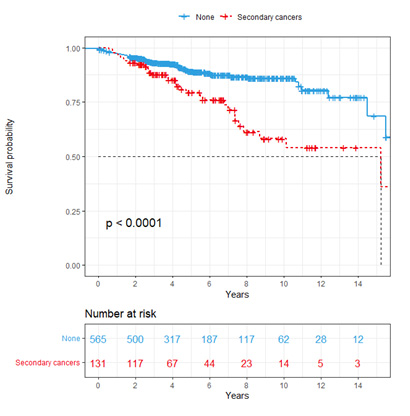Background: The development of the lymphoma treatment increased the number of patients with long-term survival. Due to the nature of lymphoma heterogeneous group of hematological malignancies, lymphoma treatment varies based on histopathological features. Various cytotoxic chemotherapy or radiotherapy could increase patients' risk of secondary cancer. Few studies evaluated the impact on survival of co-occurring cancers in mature lymphoid malignancies.
Methods: 3953 adult patients were diagnosed with lymphoma between January 2000 and April 2021 at Yeoido and Seoul St. Mary's Hospital. The cohorts compared cohorts Standardized incidence ratio applying the Korea Central Cancer Registry (KCCR).
Results:
Among the patients Initially diagnosed with Mature-B cell neoplasm were 3001 patients (76.3%) and 711(18%) with mature T and NK cell neoplasm (5.6%) for Hodgkin lymphoma. Among the B cell neoplasm, 57% diffuse large B cell lymphomas (DLBCL) were the most common form of B cell type, followed by follicular lymphoma (FL) and marginal zone lymphoma. PTCL NOS was the most dominant in the T cell lymphoma, accounting for 26%, followed by Extranodal NK/T cell lymphoma 23% and angioimmunoblastic T cell lymphoma. Among B cell lymphoma, 10% of solid cancer co-occurred, and 1% of hematological can be combined; in T cell types, 6% were solid ca and 12% were hematological ca.
Two hundred one (4.8%) patients had historic or newly diagnosed solid cancer cases; the median diagnosed age was 64 (27-92) years. The median time to secondary cancer after diagnosis is 2 years, most common type of secondary were hung cancer, followed by thyroid and colorectal cancer. Comparing with the Korean register, the standardized Incidence Ratio of patients with lymphoma showed the highest in thyroid ca (hazard ratio (HR) = 2.65, [95% CI 1.45-4.45]), followed by lung (HR=2.14), stomach (HR=1.79), and colon (HR=1.59), In total lymphoma patients, secondary ca. doesn't offer a poor prognostic factor in total cohorts- In the case of MZL and FL (n=737), development of secondary cancer (n=131) acts as a poor prognostic factor 5 years in than count parts (n=565), 79.4 vs. 89.1%, respectively ( p <0.001). Multivariate analysis showed colorectal ca ( p <0.001, HR = 4.83, [95% CI 5.19-1103]) and transformation to DLBCL ( p <0.001, HR = 4.85, [95% CI 2.68-5.79]) affect worse outcomes on OS. In the case of CLL, multivariate analysis, treatment-related AML or MDS affects inferior survival outcomes ( p =0.02, HR = 3.99, [95% CI 1.25-12.79]).
Conclusions: Secondary cancers could increase mortality in low-grade B cell lymphoma patients. There were different types of secondary cancer affected overall survival by each subtype. In the low-grade lymphoma, secondary hematologic malignancies or Richter syndrome poorer patient results. This study suggested awareness of various combined malignancies by subtypes of patients with lymphoma.
Disclosures
Lee:Samsung: Consultancy; Achillion: Research Funding; Arrowhead: Consultancy; Kira: Consultancy; AlloVir: Consultancy; Alexion, AstraZeneca Rare Disease: Honoraria, Membership on an entity's Board of Directors or advisory committees, Research Funding.


This feature is available to Subscribers Only
Sign In or Create an Account Close Modal